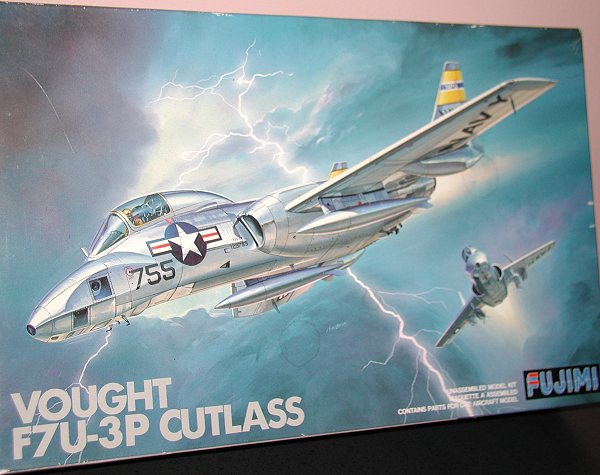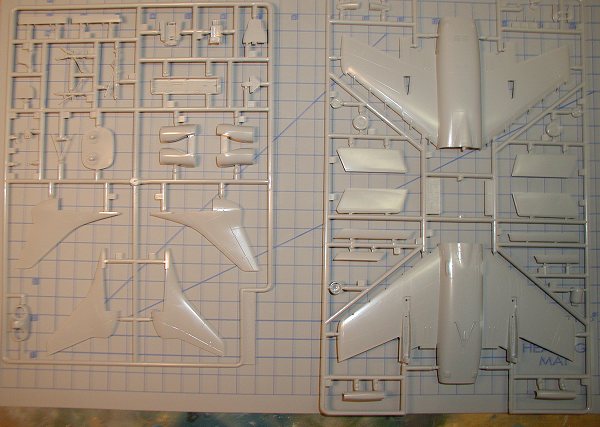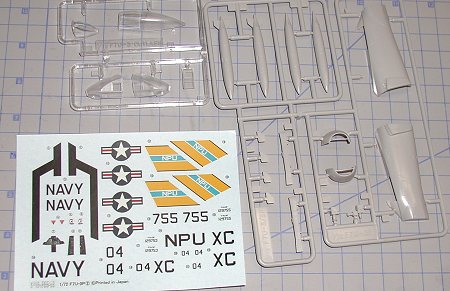
|
KIT: |
Fujimi 1/72 F7U-3P Cutlass |
|
KIT # |
H-11 |
|
PRICE: |
$12.00 on Ebay |
|
DECALS: |
Two Aircraft: VX-3 & Naval Photo Unit |
|
REVIEW & |
|
|
NOTES: |
|

|
HISTORY |
After the end of World War II the race was on to see who could grab and make use of the developing technologies that were obtained from Germany. Advances in airframe and aeronautical technology seemed to be light years ahead of the technology that had entered the war. German scientists where faced with either of a life of uncertainty in the former Soviet Union or they could look to the West. Both sides of the Iron Curtain gobbled much of the technology up and the stage was set.
When one talks about post war developing aeronautical and airframe technologies from Germany, many instances come to mind. The Me-262, Germany’s operational turbojet fighter, the Sanger theoretical “Orbital Bomber”, and several tail-less and delta wing configurations all represent emerging designs. In the late 1940’s, the United States Navy commissioned Vought Aircraft to build a carrier based aircraft that would allow the Navy to exceed the speed of sound. Based on work that was ascertained from the Germany aircraft maker Arado, the Vought designers developed a tail-less design known as the XF7U. Nicknamed the Cutlass, its initial flight was on September 29, 1948.
Initially powered by two J34 turbo jets, this plane was to achieve “firsts” for the US Navy. It was the first to be catapulted from a carrier with an excess of 5000lbs of external stores. It also had a primitive “stabilization” fly by wire system. The Cutlass was the first to meet the demand of a Navy Carrier born fighter to exceed the speed of sound. It was also the first to drop a bomb load in excess the speed of sound. Truly the Navy thought that it had a winner on it hands.
After extensive testing, the Cutlass was developed into 3 variants and had its engines upgraded to J46s as the J34 proved to be underpowered. The F7U-3 was your standard fighter ship borne fighter. The F7U-3M was identical to the F7U-3 but had provision for the carrying 4 Sparrow I “beam-riding” Missiles. The F7U-3P was the photo- reconnaissance version of the Cutlass. It was identified by it modified bulged forward end. A total of 12 of these Photo Reconnaissance aircraft where built.
While these aircraft where in service, the Cutlass gained a reputation of being a “hand full to fly”. The long nose strut, while lowered from the prototype, still caused problems for the Naval Aviators. The aircraft even with the upgraded was deemed to still be underpowered and was given the nickname the “Gut-less” The aircraft entered Naval Service 1952 was finally retired from service 1957. Its replacement was the F8 Crusader.
|
THE KIT |

 This is
the excellent 1/72 scale Fujimi F7U-3P. This kit was released in late 1987 and
don’t believe that it has been released since then. Here’s what you get. The
kit comes with 1 clear sprue that has the canopy as well as the transparent nose
for the photo recon cameras. There are two generic F7U sprues that include the
main body assembly cockpit vertical stabilizers and such. Designed this way to
reduce production costs I’ am sure. There is one sprue that holds both sides of
the front fuselage. All parts are finely engraved and look to be in great
condition and each sprue comes in its own separate bag.
This is
the excellent 1/72 scale Fujimi F7U-3P. This kit was released in late 1987 and
don’t believe that it has been released since then. Here’s what you get. The
kit comes with 1 clear sprue that has the canopy as well as the transparent nose
for the photo recon cameras. There are two generic F7U sprues that include the
main body assembly cockpit vertical stabilizers and such. Designed this way to
reduce production costs I’ am sure. There is one sprue that holds both sides of
the front fuselage. All parts are finely engraved and look to be in great
condition and each sprue comes in its own separate bag.
There is one point of contention that I have noticed with this kit. If you look at the main gear and front gear, there are sink marks on the landing gear tires. Why on earth are there sink marks on these particular part is beyond me. Detailers may find some resin update wheels, but for me, filler will do just fine.
Decals are included for two aircraft. One as shown on the box art is from the Naval Photographic Unit. The other is from test squadron VX-3. If you want to see what the 'normal' Fujimi F7U looks like, please visit this review done several years ago.
|
CONCLUSIONS |
All in all this really does not look like that bad of a kit. Outside of the small sink marks in the wheels, the kit appears flawless. I can highly recommend this kit to modelers who have a few 1/72 kits under their belts. This is certainly a must for all 1950’s Naval Jet lovers.
If you would like your product reviewed fairly and quickly by a site that has over 100,000 visits a month, please contact me or see other details in the Note to Contributors.